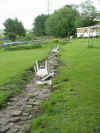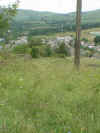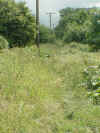 |
. |
Around the bend from the roundabout looking at
the tramway from the opposite side of the A6 it follows the line of the
trees hugging the hill moving to the right of the picture, you can make out an old quarry
just above the embankment. The section before this was very overgrow
due to summer growth and as such was inaccessible, hence why I took the picture from
an advantage point. |
 |
. |
Having walk 50 yards down the
A6. I climbed
the embankment near a retaining wall and managed to get on the Tramway
at this point to which there was a rough path on it, doesn't look it
on the photo but there is. This path must have started at the section
where the railway goes through the second tunnel where there is a little
yard and the Tramway starts
to go around the clough side. So access may be gained at this point. |
 |
. |
The dog had no trouble managing the
undergrowth. Both sides of the Tramway are still lined with stone
walls in relatively good condition along its way. The soil undergrowth is deep so no
cobbles or sleeper-stones are visible but I guess their still there. |
 |
. |
Coming around the clough we are now at the
section where it turns left around the hill heading towards the Top of
the Plane. |
 |
. |
In the distance behind the trees
is the Smithy at the Top of the Plane as it continues
turning left. |
 |
. |
Same view, but you can see in the distance the
stone wall heading down the hill at 90 degrees to the left, being the
Inclineplane.
At the end of these trees just pass the pylon, the Tramway enters a
private garden belonging to the converted Smithy now a house, as such there is a footpath though a gate to the left
leading onto Ashborune lane. This private garden belongs to the present
owner of the old Smithy building now converted into a house. |
 |
. |
Where the Tramway went into the
Smithy garden in the previous picture, this is the garden, looking
towards where it comes into the garden.
The garden path is actually the Tramway cobbles and sleepers and in
the background are the trees and pylon.
The present owner gave me a mini tour of their property they couldn't
understand why things wouldn't grow to well and on investigation found
it was full of cobbles, they dug out
the path exposed the cobbles and made a path of it. According to
them the previous owners may have put top soil over the garden, as they
had horses on it.
|
 |
. |
Close up of the cobbles and one
sleeper. |
 |
. |
Another close up. |


|
. |
In the garden, looking
at the Smithy, which in an older photo contains Joseph Marchington. Joseph
was born in 1882, so the old photo taken outside the Smithy featuring him
could indicate that it was taken circa 1910–1920. In 1901, Joseph lived at
Higher Halstead's Farm with his father, and both were listed as waggoners
at the limestone quarry. At this point in time, the Marchingtons bred
horses at Halstead's and operated teams of horses for the tramway. They
were ideally placed, with the tramway running at the bottom of the farm.
They would later go on to form haulage companies. Across from the Smithy
is where the brake hut was situated, as shown in the following picture. |
 |
. |
Where the trees are are the
foundations of the Brake hut are clearly visible. The picture is a bit blurry due to my dog
pulling on the lead.
Philip Marchington operated the Brake house c1891.
|
 |
. |
Present owners found a wheel
in the garden and
placed it in the wall, they borrowed a metal detector to look for other
bits but it wouldn't stop
bleeping! know wonder! |
 |
. |
Picture from the smithy
looking at the Top of the Plane house. Philip Marchington was living
here in the 1871 census return and is stated as a Railway labourer. In
1881 he's stated as a Booking Clark on the Railways, in 1891 a Tramway
Clerk and finally in 1901 at the age of 86 he's stated as: Breaksman At Inclined
Plane. Currently the house has just been sold and the current owners
intend to remove the rendering. |
 |
. |
At the top of the beginning of
the Incline looking down towards Townsend, Chapel. |
 |
. |
Getting towards the bottom
beyond the trees the tramway crosses a Bungalows driveway onto Ashborne
lane from this point the pathway is inaccessible and has been built on
as it goes under Market street into the the present Council yard at
Townsend. |
|


|
|
One of the old surviving waggons. Its currently in
the National Rail Museum in York. Its tucked out of sight in a far
corner of the museum, if the Tramway ever has a local museum in Chapel
it should be returned so it can be place in context and given a proper
display.
|
 |
|
Some of the old surviving trackway from the tramway. On display in
the National Rail Museum in York, however its tucked out of sight and is
not displayed but you can ask to look...
|